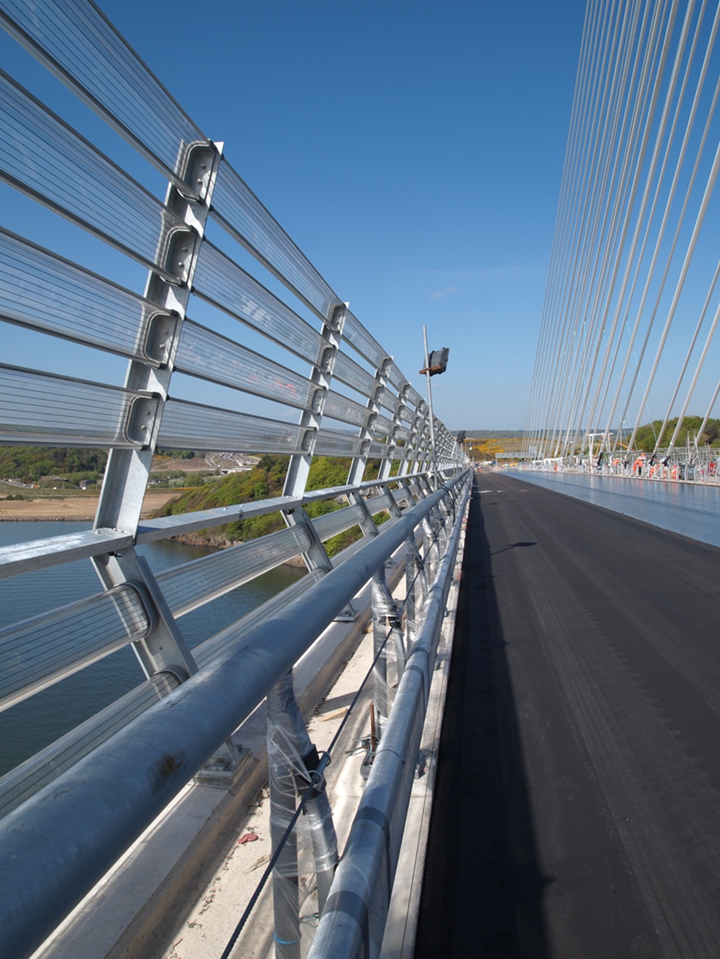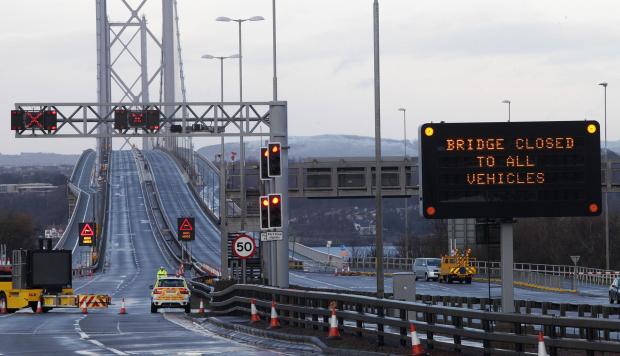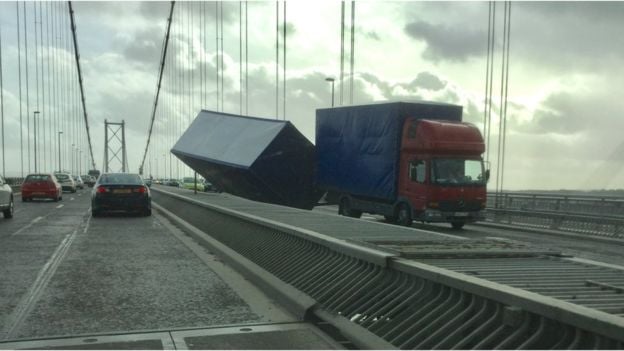
The Firth of Forth has a new bridge, linking Edinburgh to the Kingdom of Fife. It has the highest bridge towers in the UK and will be the major commuter route across the water and link to northern Scotland.
There are now three bridges across the Forth:
The famous Forth Bridge, a major Scottish landmark and UNESCO World Heritage Site, which is a rail bridge.
The Forth Road Bridge (FRB) famed for closing in high winds, getting closed when certain people drive their lorries across in quite high winds when signs say No high sided vehicles. Also, late in 2015, the bridge had to be quickly shut due to structural cracks and caused mayhem in the Central belt of Scotland to cars, taxis, delivery drivers, and lorries. The FRB isn’t up to the job anymore, there is just too much traffic for a bridge built over 50 years ago, and the cables are losing strength. Even before the temporary structural closure, a new bridge had been planned and started – The Queensferry Crossing.
Wind shielding
So, we have a new modern crossing and it’s not going to close in high winds!
This bridge is high tech and more resistant to climate and deterioration than the FRB, using more durable materials and it’s easier to replace the cables. It’s got very modern paint, thicker road surfacing and most importantly Wind Shielding.

Adding wind barriers along a very wide bridge adds weight and costs more. Investigations looked at the Severn River crossings, the old one doesn’t have wind shielding and closes in high winds, the second, newer one does and rarely, if ever since 1996, closes. The Firth of Forth is windier. In the period 1973-1991 the site had gale force winds for an average of 400 hours per year. If the gales blew for 6 hours a day, then that is still 66 days, over 2 months f high winds. Mostly the gales come November through to March. However, even in summer, there can be high winds with channeling occurring through the central lowlands in a westerly. In the prevailing SW winds, southbound traffic is more affected than northbound as the crossing lies SSW-NNE. It was decided that the wind shielding would be well worth the investment and the entire length of the bridge has this wind protection in place.

Engineers believe the bridge should never have to close due to vehicles in strong winds. Some vehicles are more prone than others WSVs – Wind Susceptible Vehicles, such as Luton vans, caravans, trailers and motorbikes, high sided lorries, especially when empty. The ones that end up on their side across on carriageway and make all eastern Scotland and truckers at the northern end of the A1 groan as everything grinds to a halt.
Fingers crossed this wind shielding will do the business.

Queensferry
The name was decided through a ‘Name the Bridge’ process of suggestions, top five options and then a public vote. Caledonia Bridge was second with 31% and Queensferry Crossing won with 35.5% back in 2013. North Queensferry and South Queensferry are on either side of the Forth, and are named after Queen Margaret (St. Margaret) like the nearby University. She set up a ferry to carry pilgrims across the water on their way to St Andrews in the 11th Century.
What is allowed on which bridge?
The Forth Bridge stays with trains.
The FRB will become open to buses, taxis, bicycles and pedestrians- less strain on the aging structure.
The Queensferry Crossing is for cars, lorries and vans, motorbikes and will be like a motorway with a 70mph limit
However, there is a bit of shuffling about to be done with opening ceremonies and adjustments first.
Timetable
29th August 2017 is the first day the Queensferry crossing is open to vehicles, with an initial 40mph speed limit. The FRB temporarily closes to all vehicles except for bikes, and pedestrians, until the weekend.
Saturday 2nd Sunday 3rd Sept The crossing will be closed to vehicles ready for the Queensferry Crossing Experience, where 50,000 members of the public can walk across the bridge. A ballot was held for tickets, so don’t just turn up.
The Queen and Prince Phillip are coming on Monday 4th for the official opening. Exactly 53 years to the day after she opened the Forth Road Bridge.
5th Sept – A community day which will allow another 10,000 local people and school children to walk across. Then that’s it, no more pedestrians.
After this, the diverted traffic from the FRB is allowed onto the new crossing once more, a bit of work on the FRB to link up some roads and make it ready to be “public transport corridor" for the buses and taxis. The speed limit on new crossing won’t go up straight away, but once everyone is settled onto the correct bridge then it will all become clear. Until the wind blows high and restrictions for buses set in on the FRB. Then they will get diverted across the Queensferry Crossing using the hard shoulder as a bus lane.What a plan!
The weather over the next few days looks quite settled, light winds and fine thanks to high pressure building into the weekend.
As we await winter with the new improved, wind proof crossing, I’ll leave you with @fakeForthBridge. Hopefully no more of this malarkey.
Loading recent activity...